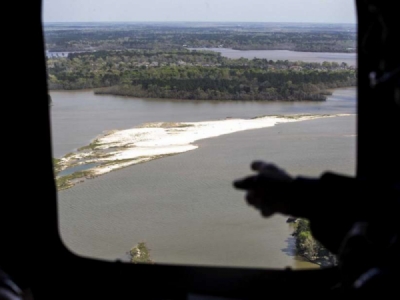
Posted on September 1, 2020
A sand bar can been seen from a helicopter window as Dave Martin, Houston city councilman, District E, left, speaks to Gov. Greg Abbott during an aerial tour over the San Jacinto River, downstream from Lake Conroe, on Thursday, March 15, 2018, in Houston. The Kingwood area suffered serious flooding during Hurricane Harvey due in part to sand washed downstream from sand mining operations along the river.
More than 1 million cubic yards of sand and sediment will be removed from the San Jacinto River after Kingwood officials waged a years-long campaign to secure federal funds for the flood mitigation project.
The U.S. Army Corps of Engineers will carry out the new operation as it also plans another $40 million dredging project in the West Fork San Jacinto River, Houston city councilmember Dave Martin announced on Aug. 22.
PHOTOS: Looking back at Harvey 3 years later
The upcoming project is moving forward after FEMA officials agreed on July 9 that much of the remaining sand and sediment in the Kingwood mouthbar was deposited during Hurricane Harvey, Martin said. It comes on the heels of a $70 million dredging project in 2019 that targeted the mouthbar — which altered the direction of the flow of the river and increased flooding.
The additional dredging was not included in the initial $70 million project because federal officials initially said much of the mouthbar was deposited before or after Hurricane Harvey. Federal dollars used to fund the dredging project stipulated that it can only be used for damage specifically caused during the 2017 storm.
“As we enter another hurricane season in Texas, I am grateful that the USACE re-evaluated this project,” U.S. Representative Dan Crenshaw said in a statement. “We will finally be able to remove the additional debris near the mouth bar from Harvey. This will greatly assist our efforts to prepare for this hurricane season, which is why I worked so hard with FEMA and (the Texas Division of Emergency Management) to win this appeal for the City of Houston.”
Most of the details in the new project are pending but will be processed when possible, including the timeline for the project, Martin said. They are also working to prepare construction documents, identifying disposal sites for the debris, selecting a dredging method and receiving the estimated cost.
HURRICANE LAURA: The storm left a trail of destruction in Louisiana, East Texas
Rodger’s Gully at Lake Houston, where approximately 200,000 cubic yards of sand and sediment were deposited and have created a mouth bar, is one of the potential locations for dredging.
The campaign for additional dredging began after the City of Houston submitted a 94-page report to FEMA showing 1,012,000 cubic yards of sand and sediment from Hurricane Harvey had not been removed by the USACE following the $70 million emergency dredging project. The USACE responded with a four-page report, detailing that they had completed the dredging for deposits from Harvey.
“For the past two years I have advocated for the dredging of this area due to the sand deposits from Hurricane Harvey, and I was committed to making sure we got this taken care of before our next major storm,” Martin said in an email… “It is very rewarding personally, and fantastic for our community to finally get to this point, however, there is still a great deal of work to be done.”
Additionally, Martin said he and Crenshaw worked alongside State Representative Dan Huberty, State Senator Brandon Creighton, Texas Division Emergency Management Chief Nim Kidd, Mayor Sylvester Turner and Chief Recovery Officer Stephen Costello to appeal for federal funding for the additional dredging.
Crenshaw, along with Congressman Kevin Brady, Senator Ted Cruz and Senator John Cornyn, wrote a signed letter in Oct. 24 last year advocating for additional dredging.
“I look forward to staying on top of this as we wait to receive these funds and I know Congressman Crenshaw is ready to continue to be our watchdog during this process,” Martin said.
The project will also require local funds from the state of Texas, Houston and Harris County. The city and county will supplement the remaining funds from Senate Bill 500, which was approved by the Texas Legislature in 2019 and set aside $30 million for dredging projects in the San Jacinto River.
Breaking News: Get email alerts from Chron.com sent directly to your inbox
The city of Houston also plans to coordinate with the Harris County Flood Control District to use a portion of the $10 million earmarked for Kingwood projects from the $2 billion voter-approved bond to fund the removal. County funds are expected to be available sometime between July 2021 and March 2022, at which point the city of Houston would be capable of starting dredging within 30-45 days.
“Up until now we’ve been lucky, but this work needs to get done ASAP,” Martin said.
savannah.mehrtens@chron.com
Source: chron





